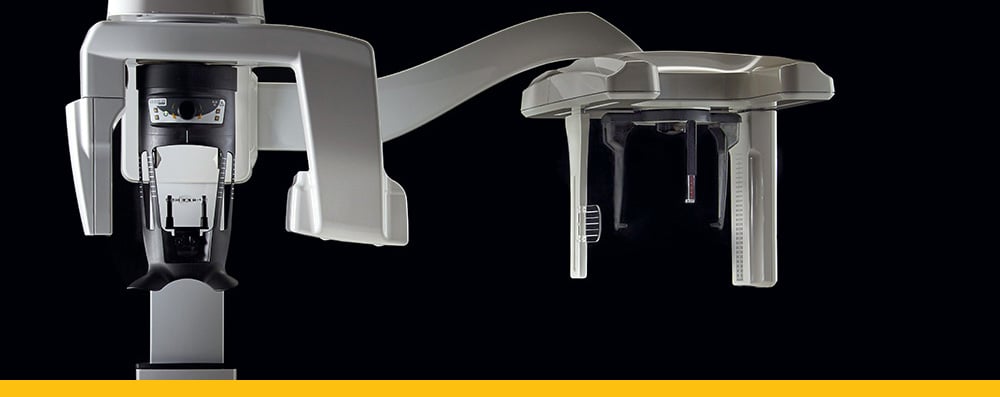CBCT Your Way to Implant Success

As is true for every healthcare professional, dental practitioners cannot treat what they can’t see. Good visualization of the problem presented by each patient and precise information on the existing anatomy are both essential for successful treatment, regardless of the type of dentistry required.
For dental implant therapy, diagnostic imaging has become especially important since accurate planning is vital for successful outcomes. Associated technologies have therefore evolved considerably over the past decade or so. An array of imaging systems is now available that deliver minute details needed to ensure safe, effective and predictable care for various types of patients.
Types of Imaging
As you may know, the range of imaging solutions available on the dental market today include panoramic, cephalometric, CT and CBCT. Each modality differs in advantages and disadvantages; each is suitable for different cases and ideal at various stages during the treatment process. The decision to use one over the other, or even a combination of techniques, depends on several factors such as cost, availability, amount of radiation exposure, and the patient’s anatomy. Every clinician looks to minimize potential risks for patients.[1] Assessment of each individual case and selection of the most appropriate imaging modality is important for optimum results. [2]
Confirming Appropriate Treatment
The objective of imaging – regardless of the problem suspected or type of imaging used – is to determine the most effective treatment for the patient. With regards to dental implantology, the images generated help to establish whether the patient can tolerate the preferred method of treatment. These images provide the information needed to select the best location for the implant(s), avoiding vital anatomical structures like the nerves and the maxillary sinus. Imaging also enables practitioners to identify the most appropriate implant position, angle, length and width.
Prosthetically-Driven Planning
Effective imaging also helps to ensure the correct position of the abutment and prosthesis, while playing a role in the monitoring of post-operative healing and on-going maintenance.[3] In fact, there has been a move towards prosthetically-driven implant treatment planning, whereby clinicians consider the final prosthesis position and shape first, before planning implant placement accordingly. The method ensures sufficient support for the desired prosthesis and allows clinicians to deliver the ideal function and aesthetics for the patient.
CBCT
In response to the increased demands placed on dental imaging solutions, CBCT machines continue to grow in popularity. Their high accuracy and relatively low radiation dose compared to other imaging methods are believed to have contributed to their rising favor,[4] giving practitioners all the information they need to diagnose and plan implant treatment safely.
CBCT imaging makes flapless implant surgery more viable, enabling clinicians to utilize less invasive intervention with the potential benefits of shorter treatment time, improved patient comfort and preserved soft tissue profiles.[5] CBCT images are also exported as DICOM (Digital Imaging and Communication in Medicine) files, which facilitate patient identification and can be reliably reported on aid compliance with GDPR (General Data Protection Regulations).
Equipment Selection
Finding the right equipment for your practice is crucial to ensure you have the tools you need to deliver effective implant treatment for your patients. A balance between sophisticated technology and simple user interactions will help enhance diagnostics and treatment planning while still facilitating a simple workflow for the dental team. In turn, treatment and surgery times can be optimized, patient chair time minimized and satisfaction of both patient and practitioner improved. With the latest technologies on the market, all this can be achieved without compromising the quality of imaging produced or the standard of treatment delivered.
The versatility of the equipment should also be considered according to the practice’s most common applications. For example, if you offer a variety of treatments, having the ability to easily switch between panoramic and 3D imaging could be useful.
It’s clear that digital imaging has become essential for safe and predictable diagnostics and treatment planning, particularly in dental implantology. Making use of the many benefits available by investing in the right system for your practice is the first step in delivering outstanding quality of care to all your patients.
[1] Jayadevappa BS, Kodhandarama GS, Santosh SV, Rashid WT. Imaging of dental implants. J Oral Health Res. 2010;1:50–61.
[2] Nagarajan A, Perumalsamy R, Thyagarajan R, Namasivayam A. Diagnostic Imaging for Dental Implant Therapy. Journal of Clinical Imaging Science. 2014;4(Suppl 2):4. doi:10.4103/2156-7514.143440.
[3] Gupta S, Patil N, Solanki J, Singh R, Laller S. Oral Implant Imaging: A Review. The Malaysian Journal of Medical Sciences : MJMS. 2015;22(3):7-17.
[4] Gupta J, Ali SP. Cone beam computed tomography in oral implants. National Journal of Maxillofacial Surgery. 2013;4(1):2-6. doi:10.4103/0975-5950.117811.
[5] Ravindran DM, Sudhakar U, Ramakrishnan T, Ambalavanan N. The efficacy of flapless implant surgery on soft-tissue profile comparing immediate loading implants to delayed loading implants: A comparative clinical study. Journal of Indian Society of Periodontology. 2010;14(4):245-251. doi:10.4103/0972-124X.76930.






